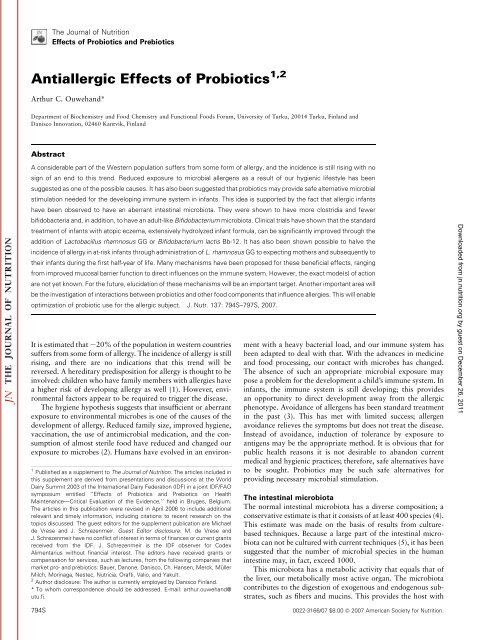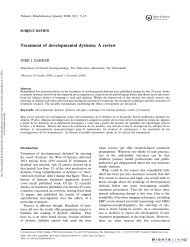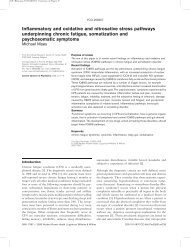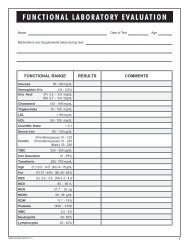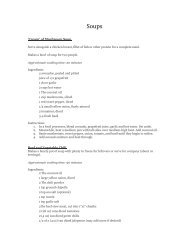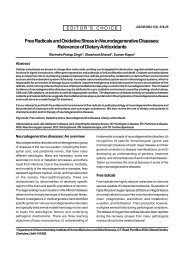Antiallergic Effects of Probiotics - Integrative Health Connection
Antiallergic Effects of Probiotics - Integrative Health Connection
Antiallergic Effects of Probiotics - Integrative Health Connection
Create successful ePaper yourself
Turn your PDF publications into a flip-book with our unique Google optimized e-Paper software.
The Journal <strong>of</strong> Nutrition<br />
<strong>Effects</strong> <strong>of</strong> <strong>Probiotics</strong> and Prebiotics<br />
<strong>Antiallergic</strong> <strong>Effects</strong> <strong>of</strong> <strong>Probiotics</strong> 1,2<br />
Arthur C. Ouwehand*<br />
Department <strong>of</strong> Biochemistry and Food Chemistry and Functional Foods Forum, University <strong>of</strong> Turku, 20014 Turku, Finland and<br />
Danisco Innovation, 02460 Kantvik, Finland<br />
Abstract<br />
A considerable part <strong>of</strong> the Western population suffers from some form <strong>of</strong> allergy, and the incidence is still rising with no<br />
sign <strong>of</strong> an end to this trend. Reduced exposure to microbial allergens as a result <strong>of</strong> our hygienic lifestyle has been<br />
suggested as one <strong>of</strong> the possible causes. It has also been suggested that probiotics may provide safe alternative microbial<br />
stimulation needed for the developing immune system in infants. This idea is supported by the fact that allergic infants<br />
have been observed to have an aberrant intestinal microbiota. They were shown to have more clostridia and fewer<br />
bifidobacteria and, in addition, to have an adult-like Bifidobacterium microbiota. Clinical trials have shown that the standard<br />
treatment <strong>of</strong> infants with atopic eczema, extensively hydrolyzed infant formula, can be significantly improved through the<br />
addition <strong>of</strong> Lactobacillus rhamnosus GG or Bifidobacterium lactis Bb-12. It has also been shown possible to halve the<br />
incidence <strong>of</strong> allergy in at-risk infants through administration <strong>of</strong> L. rhamnosus GG to expecting mothers and subsequently to<br />
their infants during the first half-year <strong>of</strong> life. Many mechanisms have been proposed for these beneficial effects, ranging<br />
from improved mucosal barrier function to direct influences on the immune system. However, the exact mode(s) <strong>of</strong> action<br />
are not yet known. For the future, elucidation <strong>of</strong> these mechanisms will be an important target. Another important area will<br />
be the investigation <strong>of</strong> interactions between probiotics and other food components that influence allergies. This will enable<br />
optimization <strong>of</strong> probiotic use for the allergic subject. J. Nutr. 137: 794S–797S, 2007.<br />
1 Published as a supplement to The Journal <strong>of</strong> Nutrition. The articles included in<br />
this supplement are derived from presentations and discussions at the World<br />
Dairy Summit 2003 <strong>of</strong> the International Dairy Federation (IDF) in a joint IDF/FAO<br />
symposium entitled ‘‘<strong>Effects</strong> <strong>of</strong> <strong>Probiotics</strong> and Prebiotics on <strong>Health</strong><br />
Maintenance—Critical Evaluation <strong>of</strong> the Evidence,’’ held in Bruges, Belgium.<br />
The articles in this publication were revised in April 2006 to include additional<br />
relevant and timely information, including citations to recent research on the<br />
topics discussed. The guest editors for the supplement publication are Michael<br />
de Vrese and J. Schrezenmeir. Guest Editor disclosure: M. de Vrese and<br />
J. Schrezenmeir have no conflict <strong>of</strong> interest in terms <strong>of</strong> finances or current grants<br />
received from the IDF. J. Schrezenmeir is the IDF observer for Codex<br />
Alimentarius without financial interest. The editors have received grants or<br />
compensation for services, such as lectures, from the following companies that<br />
market pro- and prebiotics: Bauer, Danone, Danisco, Ch. Hansen, Merck, Müller<br />
Milch, Morinaga, Nestec, Nutricia, Orafti, Valio, and Yakult.<br />
2 Author disclosure: The author is currently employed by Danisco Finland.<br />
* To whom correspondence should be addressed. E-mail: arthur.ouwehand@<br />
utu.fi.<br />
It is estimated that ;20% <strong>of</strong> the population in western countries<br />
suffers from some form <strong>of</strong> allergy. The incidence <strong>of</strong> allergy is still<br />
rising, and there are no indications that this trend will be<br />
reversed. A hereditary predisposition for allergy is thought to be<br />
involved: children who have family members with allergies have<br />
a higher risk <strong>of</strong> developing allergy as well (1). However, environmental<br />
factors appear to be required to trigger the disease.<br />
The hygiene hypothesis suggests that insufficient or aberrant<br />
exposure to environmental microbes is one <strong>of</strong> the causes <strong>of</strong> the<br />
development <strong>of</strong> allergy. Reduced family size, improved hygiene,<br />
vaccination, the use <strong>of</strong> antimicrobial medication, and the consumption<br />
<strong>of</strong> almost sterile food have reduced and changed our<br />
exposure to microbes (2). Humans have evolved in an environment<br />
with a heavy bacterial load, and our immune system has<br />
been adapted to deal with that. With the advances in medicine<br />
and food processing, our contact with microbes has changed.<br />
The absence <strong>of</strong> such an appropriate microbial exposure may<br />
pose a problem for the development a child’s immune system. In<br />
infants, the immune system is still developing; this provides<br />
an opportunity to direct development away from the allergic<br />
phenotype. Avoidance <strong>of</strong> allergens has been standard treatment<br />
in the past (3). This has met with limited success; allergen<br />
avoidance relieves the symptoms but does not treat the disease.<br />
Instead <strong>of</strong> avoidance, induction <strong>of</strong> tolerance by exposure to<br />
antigens may be the appropriate method. It is obvious that for<br />
public health reasons it is not desirable to abandon current<br />
medical and hygienic practices; therefore, safe alternatives have<br />
to be sought. <strong>Probiotics</strong> may be such safe alternatives for<br />
providing necessary microbial stimulation.<br />
The intestinal microbiota<br />
The normal intestinal microbiota has a diverse composition; a<br />
conservative estimate is that it consists <strong>of</strong> at least 400 species (4).<br />
This estimate was made on the basis <strong>of</strong> results from culturebased<br />
techniques. Because a large part <strong>of</strong> the intestinal microbiota<br />
can not be cultured with current techniques (5), it has been<br />
suggested that the number <strong>of</strong> microbial species in the human<br />
intestine may, in fact, exceed 1000.<br />
This microbiota has a metabolic activity that equals that <strong>of</strong><br />
the liver, our metabolically most active organ. The microbiota<br />
contributes to the digestion <strong>of</strong> exogenous and endogenous substrates,<br />
such as fibers and mucins. This provides the host with<br />
Downloaded from jn.nutrition.org by guest on December 26, 2011<br />
794S<br />
0022-3166/07 $8.00 ª 2007 American Society for Nutrition.
Figure 1 Development <strong>of</strong> the ‘‘allergic’’ (Th2) or ‘‘tolerant’’ (Th1) phenotype.<br />
IL-10 stimulates the maintenance <strong>of</strong> the allergic phenotype, whereas IL-12<br />
stimulates a shift toward the tolerant phenotype. Th3 cells, through the production<br />
<strong>of</strong> transforming growth factor-b, further stimulate the shift toward<br />
tolerance. IgE may activate mast cells and cause allergic symptoms; IgA on the<br />
other hand may provide allergen exclusion.<br />
additional energy in the form <strong>of</strong> fatty acids (6). It may, however,<br />
also expose the host to detrimental metabolic endproducts such<br />
as amines, sulfides, ammonia, etc.<br />
Another important function <strong>of</strong> the intestinal microbiota is to<br />
provide a protective barrier against incoming bacteria, e.g.,<br />
potential pathogens. This colonization resistance works through<br />
several different mechanisms: competition for nutrients and<br />
binding sites and production <strong>of</strong> antimicrobial substances (7).<br />
The intestine is the body’s largest immune organ; most <strong>of</strong> the<br />
antibody-producing cells reside in the intestine (8). A relatively<br />
recently recognized function <strong>of</strong> the intestinal microbiota is to<br />
provide stimulation <strong>of</strong> the immune system. Consumption <strong>of</strong><br />
probiotics (and prebiotics) is, in most cases, aimed at modulating<br />
the composition and/or activity <strong>of</strong> the intestinal microbiota<br />
(9). This modulation can be expected to influence the immune<br />
system. Indeed, several probiotic strains have been observed to<br />
modulate some immune parameters after sufficient (time and<br />
amount) consumption (10–12). However, in many cases it is<br />
uncertain what the actual health benefit <strong>of</strong> this immune modulation<br />
is for the consumer, in particular the healthy consumer.<br />
The intestinal immune system<br />
At birth, the immune system <strong>of</strong> an infant is not fully developed<br />
and tends to be directed toward a T-helper (Th)2 phenotype 3<br />
(Fig. 1) to prevent rejection in utero. The Th2 phenotype leads,<br />
however, to the stimulated production <strong>of</strong> IgE by B cells and thus<br />
increases the risk for allergic reactions through activation <strong>of</strong><br />
mast cells. Microbial stimulation early in life will reverse the<br />
Th2 bias and stimulate the development <strong>of</strong> a Th1 phenotype and<br />
stimulate the activity <strong>of</strong> Th3 cells (13). Their combined action<br />
will lead to the production <strong>of</strong> IgA by B cells. IgA contributes to<br />
allergen exclusion and will thereby reduce exposure <strong>of</strong> the<br />
immune system to antigens. Cytokines produced by the Th1<br />
phenotype will also reduce inflammation and stimulate tolerance<br />
toward common antigens (14).<br />
3 Abbreviations used: Ig, immunoglobulin; SCORAD, clinical scoring <strong>of</strong> atopic<br />
dermatitis; Th, helper T cells.<br />
The intestinal microbiota <strong>of</strong> allergic infants<br />
In the case <strong>of</strong> allergy, the rationale for modulating the intestinal<br />
microbiota is supported by observations that allergic children<br />
have a different microbiota composition than healthy infants.<br />
Children with allergy were found to have an aberrant microbiota<br />
even before the onset <strong>of</strong> allergy; they had higher levels <strong>of</strong><br />
clostridia and lower levels <strong>of</strong> bifidobacteria (15,16). In addition<br />
to these quantitative differences in the Bifidobacterium microbiota,<br />
qualitative differences have also been observed. Infants<br />
with atopic dermatitis have been found to have a more adult<br />
type Bifidobacterium microbiota with high prevalence <strong>of</strong> B.<br />
adolescentis. <strong>Health</strong>y infants, on the other hand, were found to<br />
be colonized mainly by B. bifidum, typical for breast-fed infants<br />
(17,18). However, children with respiratory allergy symptoms<br />
did not exhibit an aberrant microbiota composition (18). The<br />
bifidobacteria from infants with atopic dermatitis were found<br />
to induce a higher secretion <strong>of</strong> proinflammatory cytokines in<br />
vitro, whereas the bifidobacteria from healthy infants induced<br />
the secretion <strong>of</strong> more antiinflammatory cytokines (19). Also,<br />
bifidobacteria <strong>of</strong> dairy origin stimulated more antiinflammatory<br />
and less inflammatory cytokines than bifidobacteria from<br />
allergic infants. In addition to differing in their induction <strong>of</strong><br />
cytokines, bifidobacteria from allergic and healthy infants also<br />
exhibited different in vitro adhesion to Caco-2 tissue culture<br />
cells (20) and intestinal mucus (21). This difference in adhesion<br />
to the intestinal mucosa may result in a different or reduced<br />
stimulation <strong>of</strong> the immune system through the gut-associated<br />
lymphoid tissue.<br />
Not only the composition <strong>of</strong> the intestinal microbiota but<br />
also the metabolic activity <strong>of</strong> the microbiota may be different.<br />
Swedish children, who are at high risk to develop allergy, were<br />
found to have significantly higher levels <strong>of</strong> fecal butyrate,<br />
isovalerate, and caproate then Estonian children, who have a<br />
low risk for developing allergies (22).<br />
Treatment <strong>of</strong> atopic disease<br />
A limited number <strong>of</strong> strains have been tested for their efficacy in<br />
the treatment and prevention <strong>of</strong> allergy in infants. Allergy may<br />
manifest in infants even when they are exclusively breast-fed.<br />
Standard treatment involves the feeding <strong>of</strong> extensively hydrolyzed<br />
formula (3). Supplementation <strong>of</strong> this type <strong>of</strong> formula with<br />
Bifidobacterium lactis Bb-12 or Lactobacillus rhamnosus GG<br />
has been found to lead to an earlier recovery than standard treatment<br />
alone, 2 mo vs. 6 mo (23). A combination <strong>of</strong> 2 Lactobacillus<br />
strains, L. rhamnosus 19070–2 and L. reuteri DSM 122460,<br />
was found to significantly reduce the clinical scoring <strong>of</strong> atopic<br />
dermatitis (SCORAD) in 1- to 13-y-old children with a positive<br />
skin prick test. But the SCORAD <strong>of</strong> children with no positive skin<br />
prick test remained unchanged. Interestingly, more than half <strong>of</strong><br />
the subjects reported an improvement in their eczema, whereas<br />
only 15% in the placebo group reported improvement (24).<br />
The 2 studies discussed used different probiotics preparations;<br />
this may explain the observed differences in outcome. But<br />
the differences may also relate to the differences in age <strong>of</strong> the<br />
patients studied. In young infants, the immune system is still developing.<br />
There is still a possibility to direct it toward tolerance.<br />
In older children, the allergic phenotype is already established,<br />
and here one may only be able to relieve the symptoms.<br />
Similarly, probiotics have not been very successful in alleviating<br />
symptoms <strong>of</strong> respiratory allergy. L. rhamnosus GG was not able<br />
to reduce the symptoms <strong>of</strong> birch pollen allergy in adults (25)<br />
despite its effectiveness in children. Similarly, L. acidophilus<br />
L-92 was reported only to relieve the subjective symptoms <strong>of</strong> cedar<br />
pollen allergy in adults (26).<br />
Downloaded from jn.nutrition.org by guest on December 26, 2011<br />
<strong>Antiallergic</strong> effects <strong>of</strong> probiotics<br />
795S
Prevention <strong>of</strong> allergic disease<br />
In addition to treatment <strong>of</strong> allergy, it has been observed that<br />
selected probiotics can reduce the risk for the development <strong>of</strong><br />
allergy. One <strong>of</strong> the earliest studies was performed with a nonpathogenic<br />
Escherichia coli administered to term and preterm<br />
infants. At 10 and 20 y <strong>of</strong> age, children treated with E. coli<br />
suffered significantly fewer allergic diseases than the subjects<br />
in the control group (27). In a recent study, the efficacy <strong>of</strong><br />
L. rhamnosus GG on at-risk infants was studied; children <strong>of</strong><br />
allergic mothers have ;50% risk <strong>of</strong> developing allergy. Pregnant<br />
allergic mothers were given L. rhamnosus GG or placebo from<br />
2 to 4 wk before the calculated date <strong>of</strong> delivery in a randomized<br />
double-blind trial. After delivery, the children received<br />
L. rhamnosus GG for 6 mo. After 4 y, 46% <strong>of</strong> the children in<br />
the placebo group had developed atopic eczema, whereas in the<br />
probiotics group this was 26% (28). Surprisingly, the serum IgE<br />
levels did not differ between the 2 groups. This is in contrast to<br />
observations in mice, where L. casei Shirota was able to suppress<br />
the production <strong>of</strong> IgE (29).<br />
Mechanisms <strong>of</strong> antiallergic probiotic action<br />
The precise mechanisms behind the favorable effects <strong>of</strong> probiotics<br />
on allergy are not entirely known. Several mechanisms<br />
have been observed in vitro and in animal studies (Fig. 2). In<br />
addition to modulation <strong>of</strong> the intestinal microbiota, probiotics<br />
have been observed to improve the barrier function <strong>of</strong> the<br />
intestinal mucosa (30), reducing leakage <strong>of</strong> antigens through the<br />
mucosa and thereby exposure to them. Direct modulation <strong>of</strong> the<br />
immune system may be through the induction <strong>of</strong> antiinflammatory<br />
cytokines or through increased production <strong>of</strong> secretory IgA<br />
(31). IgA will contribute to an exclusion <strong>of</strong> antigens from the<br />
intestinal mucosa. Further, enzymatic degradation <strong>of</strong> dietary<br />
antigens by enzymes from probiotics will reduce the load <strong>of</strong> and<br />
exposure to antigens (32). These and other mechanisms contribute<br />
to reduced exposure <strong>of</strong> the immune system to dietary<br />
antigens.<br />
For the future, it will be important to determine the mechanisms<br />
behind the probiotic action on allergy. This will enable<br />
further improvement <strong>of</strong> the use <strong>of</strong> probiotics. A thorough<br />
knowledge <strong>of</strong> the intestinal microbiota <strong>of</strong> allergic and healthy<br />
infants presents an opportunity to select more effective strains or<br />
combinations <strong>of</strong> strains. Because probiotics modulate the<br />
composition and/or activity <strong>of</strong> the intestinal microbiota, it is<br />
important to obtain information on the intestinal microbiota,<br />
not only from fecal samples, as is common practice, but also<br />
Figure 2 Mechanisms by which probiotics may influence food allergy. 1)<br />
Improved mucosal barrier function. 2) Degradation <strong>of</strong> food antigens. 3) Modulation<br />
<strong>of</strong> intestinal microbiota composition and activity. 4) Stimulated production <strong>of</strong><br />
secretory IgA. 5) Change in mucus production. 6) Direct immune modulation.<br />
from the mucosa-associated microbiota. In addition to probiotics,<br />
(n-3) fatty acids (33) and antioxidants (34) have been<br />
suggested to contribute to a protection against allergy. Also,<br />
prebiotics may modulate the immune response through similar<br />
mechanisms as probiotics (35) and reduce inflammation (36).<br />
The influence on allergy <strong>of</strong> the combination <strong>of</strong> these dietary<br />
components and probiotics deserves further investigation.<br />
Thus, although probiotic therapy appears to be a promising<br />
approach in the treatment and prevention <strong>of</strong> allergy, there are<br />
still a substantial number <strong>of</strong> questions that remain to be<br />
answered.<br />
Literature Cited<br />
1. Burke W, Fesinmeyer M, Reed K, Hampson L, Carlsten C. Family<br />
history as a predictor <strong>of</strong> asthma risk. Am. J. Prev. Med. 2003;24:160–9.<br />
2. Strachan DP. Hay fever, hygiene, and household size. BMJ. 1989;299:<br />
1259–60.<br />
3. Zeiger RS. Food allergen avoidance in the prevention <strong>of</strong> food allergy in<br />
infants and children. Pediatrics. 2003;111:1662–71.<br />
4. Moore WEC, Holdeman LV. Human fecal flora: The normal flora <strong>of</strong> 20<br />
Japanese-Hawaiians. Appl Microbiol. 1974;27:961–79.<br />
5. Zoetendal EG, Akkermans ADL, de Vos WM. Temperature gradient gel<br />
electrophoresis analysis <strong>of</strong> 16S rRNA from human faecal samples<br />
reveals stable and host-specific communities <strong>of</strong> active bacteria. Appl<br />
Environ Microbiol. 1998;64:3854–9.<br />
6. Ouwehand AC, Derrien M, de Vos W, Tiihonen K, Rautonen N.<br />
Prebiotics and other microbial substrates for gut functionality. Curr<br />
Opin Biotechnol. 2005;16:212–7.<br />
7. Adlerberth I, Cerquetti M, Poilane I, Wold A, Collignon A. Mechanisms<br />
<strong>of</strong> colonisation and colonisation resistance <strong>of</strong> the digestive tract. Microb<br />
Ecol <strong>Health</strong> Dis. 2000;11(Suppl. 2):223–39.<br />
8. Brandtzaeg P. Current understanding <strong>of</strong> gastrointestinal immunoregulation<br />
and its relation to food allergy. Ann N Y Acad Sci. 2002;964:<br />
13–45.<br />
9. Saavedra JM, Tschernia A. Human studies with probiotics and<br />
prebiotics: clinical implications. Br J Nutr. 2002;87:S241–6.<br />
10. Pelto L, Isolauri E, Lilius E-M, Nuutila J, Salminen S. Lactobacillus<br />
GG modulates milk-induced immune inflammatory response in milkhypersensitive<br />
adults. In 1st Workshop Fair CT96–1028, Selection and<br />
safety criteria <strong>of</strong> probiotics. 1996. Helsinki, Finland.<br />
11. He F, Tuomola E, Arvilommi H, Salminen S. Modulation <strong>of</strong> humoral<br />
immune response through probiotic intake. FEMS Immunol Med<br />
Microbiol. 2000;29:47–52.<br />
12. Gill H, Rutherfurd KJ, Cross ML, Gopal PK. Enhancement <strong>of</strong> immunity<br />
in the elderly by dietary supplementation with the probiotic Bifidobacterium<br />
lactis HN019. Am J Clin Nutr. 2001;74:833–9.<br />
13. von der Weid T, Bulliard C, Schiffrin EJ. Induction by a lactic acid<br />
bacterium <strong>of</strong> a population <strong>of</strong> CD4 1 T cells with low proliferative<br />
capacity that produce transforming growth factor b and interleukin-10.<br />
Clin. Diagn. Lab. Immunol. 2001;8:695–701.<br />
14. Kirjavainen PV, Gibson GR. <strong>Health</strong>y gut micr<strong>of</strong>lora and allergy: factors<br />
influencing development <strong>of</strong> the microbiota. Ann Med. 1999;31:288–92.<br />
15. Sepp E, Julge K, Mikelsaar M, Bjorksten B. Intestinal microbiota and<br />
immunoglobulin E responses in 5-year-old Estonian children. Clin Exp<br />
Allergy. 2005;35:1141–6.<br />
16. Kalliomäki M, Kirjavainen P, Eerola E, Kero P, Salminen S, Isolauri E.<br />
Distinct patterns <strong>of</strong> neonatal gut micr<strong>of</strong>lora in infants developing or not<br />
developing atopy. J Allergy Clin Immunol. 2001;107:129–34.<br />
17. Ouwehand AC, Isolauri E, He F, Hashimoto H, Benno Y, Salminen S.<br />
Differences in Bifidobacterium flora composition in allergic and healthy<br />
infants. J Allergy Clin Immunol. 2001;108:144–5.<br />
18. Murray CS, Tannock GW, Simon MA, Harmsen HJ, Welling GW,<br />
Custovic A, Woodcock A. Fecal microbiota in sensitized wheezy and<br />
non-sensitized non-wheezy children: a nested case-control study. Clin<br />
Exp Allergy. 2005;35:741–5.<br />
19. He F, Morita H, Hashimoto H, Kurisaki J-I, Ouwehand AC, Isolauri E,<br />
Benno Y, Salminen S. Intestinal Bifidobacterium species induce varying<br />
cytokine production. J Allergy Clin Immunol. 2002;109:1035–6.<br />
Downloaded from jn.nutrition.org by guest on December 26, 2011<br />
796S<br />
Supplement
20. Morita H, He F, Fuse T, Ouwehand AC, Hashimoto H, Hosoda M,<br />
Mizumachi K, Kurisaki J-I. Adhesion <strong>of</strong> lactic acid bacteria to Caco-2 cells<br />
and their effect on cytokine secretion. Microbiol Immunol. 2002;46:293–7.<br />
21. He F, Ouwehand AC, Isolauri E, Hashimoto H, Benno Y, Salminen S.<br />
Comparison <strong>of</strong> mucosal adhesion and species identification <strong>of</strong><br />
bifidobacteria isolated from healthy and allergic infants. FEMS<br />
Immunol Med Microbiol. 2001;30:43–7.<br />
22. Norin E, Midtvedt T, Björkstén B. Development <strong>of</strong> faecal short-chain<br />
fatty acid pattern during the first year <strong>of</strong> life in Estonian and Swedish<br />
infants. Microb Ecol <strong>Health</strong> Dis. 2004;16:8–12.<br />
23. Isolauri E, Arvola T, Sütas Y, Moilanen E, Salminen S. <strong>Probiotics</strong> in the<br />
management <strong>of</strong> atopic eczema. Clin Exp Allergy. 2000;30:1604–10.<br />
24. Rosenfeldt V, Benfeldt E, Nielsen SD, Michaelsen KF, Jeppesen DL,<br />
Valerius NH, Paerregaard A. Effect <strong>of</strong> probiotic Lactobacillus strains in<br />
children with atopic dermatitis. J Allergy Clin Immunol. 2003;111:389–95.<br />
25. Helin T, Haahtela S, Haahtela T. No effect <strong>of</strong> oral treatment with an<br />
intestinal bacterial strain, Lactobacillus rhamnosus (ATCC 53103), on<br />
birch-pollen allergy: a placebo-controlled double-blind study. Allergy.<br />
2002;57:243–6.<br />
26. Ishida Y, Nakamura F, Kanzato H, Sawada D, Yamamoto N, Kagata H,<br />
Oh-Ida M, Takeuchi H, Fujiwara S. Effect <strong>of</strong> milk fermented with<br />
Lactobacillus acidophilus strain L-92 on symptoms <strong>of</strong> Japanese cedar<br />
pollen allergy: a randomized placebo-controlled trial. Biosci Biotechnol<br />
Biochem. 2005;69:1652–60.<br />
27. Lodinová-Zádniková R, Cukrowská B, Tlaskalová-Hogenová H. Oral<br />
administration <strong>of</strong> probiotic Escherichia coli after birth reduces frequency<br />
<strong>of</strong> allergies and repeated infections later in life (after 10 and 20<br />
years). Int Arch Allergy Immunol. 2003;131:209–11.<br />
28. Kalliomäki M, Salminen S, Pousa T, Arvilommi H, Isolauri E. <strong>Probiotics</strong><br />
and prevention <strong>of</strong> atopic disease: 4-year follow-up <strong>of</strong> a randomised<br />
placebo-controlled trial. Lancet. 2003;361:1869–71.<br />
29. Matsuzaki T, Yamazaki R, Hashimoto S, Yokokura T. The effect <strong>of</strong> oral<br />
feeding <strong>of</strong> Lactobacillus casei strain Shirota on immunoglobulin E<br />
production in mice. J Dairy Sci. 1998;81:48–53.<br />
30. Malin M, Verronen P, Korhonen H, Syväoja E-L, Salminen S,<br />
Mykkänen H, Arvilommi H, Eerola E, Isolauri E. Dietary therapy<br />
with Lactobacillus GG, bovine colostrum or bovine immune colostrum<br />
in patients with juvenile chronic arthritis: evaluation <strong>of</strong> effect on gut<br />
defence mechanisms. Inflammopharmacology. 1997;5:219–36.<br />
31. Kaila M, Isolauri E, Soppi E, Virtanen E, Laine S, Arvilommi H.<br />
Enhancement <strong>of</strong> the circulating antibody secreting cell response in<br />
human diarrhea by a human Lactobacillus strain. Pediatr Res. 1992;<br />
32:141–4.<br />
32. Pessi T, Isolauri E, Sütas Y, Kankaanranta H, Moilanen E, Hurme M.<br />
Suppression <strong>of</strong> T cell activation by Lactobacillus rhamnosus GGdegraded<br />
bovine casein. Immunopharmacology. 2001;1:211–8.<br />
33. Mermer C, Mercola J. Omega-3s and childhood asthma. Thorax. 2002;<br />
57:281.<br />
34. Shaheen SO, Sterne JAC, Thompson RL, Songhurst CE, Margetts BM,<br />
Burney PGJ. Dietary antioxidants and asthma in adults. Am. J. Respir.<br />
Crit. Care Med. 2001;164:1823–8.<br />
35. Schley PD, Field CJ. The immune-enhancing effects <strong>of</strong> dietary fibres and<br />
prebiotics. Br J Nutr. 2002;87:S221–30.<br />
36. Guigoz Y, Rochat F, Perruisseau-Carrier G, Rochat I, Schiffrin EJ.<br />
<strong>Effects</strong> <strong>of</strong> oligosaccharide on the faecal flora and non-specific immune<br />
system in elderly people. Nutr Res. 2002;22:13–25.<br />
Downloaded from jn.nutrition.org by guest on December 26, 2011<br />
<strong>Antiallergic</strong> effects <strong>of</strong> probiotics<br />
797S


